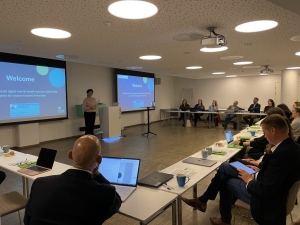– More universal design for everyone
In Norway, there is a requirement for universal design in digital services, but during Forhelse’s joint meeting in May, it emerged that there is still a long way to go.
Universal design was one of the topics discussed at Forhelse’s joint meeting in May. The center had invited Kristin Skeide Fuglerud, chief researcher and leader of the subject group for Digital inclusion at the research institute Norsk Regnesentral and Christian Thon, ICT advisor in the Norwegian Association of the Blind, to talk about the challenges of universal design in digital services.
– Universal design is important for everyone to be able to take part in the society of information. It is about self-esteem and self-mastery, says Fuglerud who is also an associate professor at the University of Southeast Norway in the Center for Health and Technology.
– I think universal design is important so that everyone can participate equally. There is already exclusion going on, so people should not have to experience it on digital platforms as well, Thon adds, whom among other things, works with universal design of apps and websites.
–What do you hope to gain from this gathering with focus on universal design?
More universal design for everyone – that is what we should gain from this gathering, says Thon.
– And that it will lead to more sustainable services and increase the quality, so that more people can use the services, Fuglerud adds.
Competence to order and knowledge are some of the barriers
According to Thon, lack of knowledge and experience are some of the reasons why one does not succeed with universal design.
– Another barrier is competence to order. If those who order do not check to see if there is universal design, it can easily be downgraded.
Fuglerud also says that it is important to remember that, as with everything else in ICT, universal design is a continous work that must be maintained and developed.
– Yes, old solutions are often a barrier. One forgets that it needs to be updated. When it comes to barriers for the user, I think that knowledge is central. One is maybe 80 years old and gets a gadget, it is a big challenge for many, says Thon.
The users must be involved
According to Thon and Fuglerud, there are several areas that can create problems for the user. Among other things, login can be a problem as it is difficult to use Bank-ID if one is not a Norwegian citizen or under 16 years of age.

– When working with universal design, involving users is very important. One thing is technical accessibility, if it follows a standard then it is universally designed in theory, but to be truly universal one must involve the user. One should like to have more user representatives on a general basis and collaborate with interest organizations, says Fuglerud.
-I think it is wise to be able to show people how the system is used by those concerned. When designing a store, the store must have a nice flow. But if I have found my way into the store through the warehouse – how user-friendly is the solution then? Seeing the solution being torn to shreds by users can be an eye-opener for many, Thon adds.
They both add that one must not forget honoring the users. They are often expected to work for free, but more people should make it easy for them to get paid for the work they do as they are the experts in their challenges.
Advice from Kristin Fuglerud on how to get started with universal design in research projects: When securing universal design in research projects, it is a good idea to start by checking that you comply with legal requirements, ie WCAG (Web Content Accessibility Guidelines) before consulting with users. WCAG are guidelines for how digital content can be made more easily accessible for people with disabilities, and the elderly with age-related functional challenges. Once you have followed these guidelines, it is important to also get user evaluations to ensure utility. One can get in touch with users through interest groups and councils.













